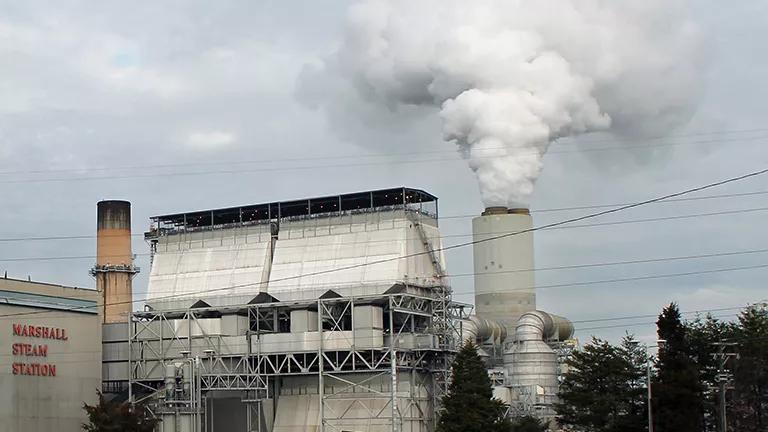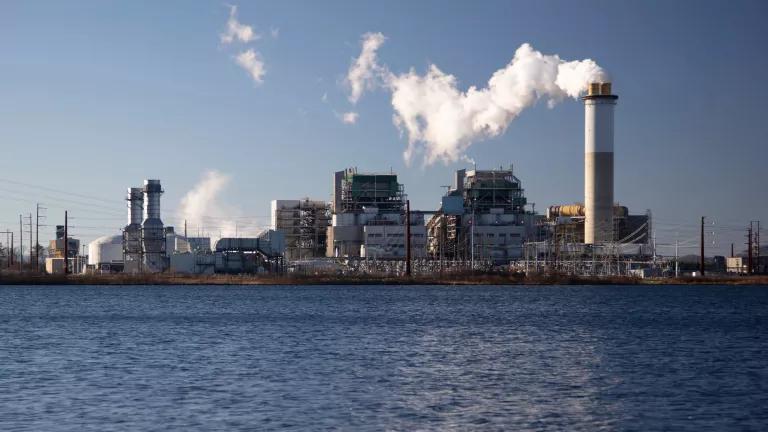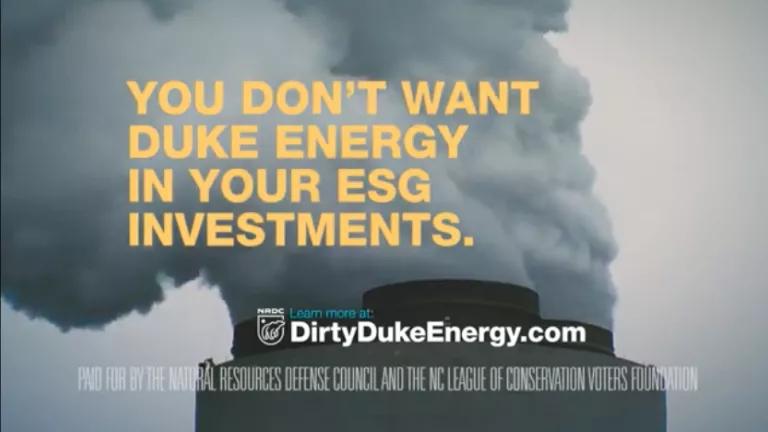Carolina Climate on Our Minds
After many ups-and-downs, North Carolina is committing to 70% reductions in power-sector carbon dioxide emissions by 2030 and carbon neutrality by 2050!

After many ups-and-downs, North Carolina is committing to 70% reductions in power-sector carbon dioxide emissions by 2030 and carbon neutrality by 2050!
HB 951 Charts a Bipartisan Path Forward on Clean Energy
In June, Pro-Duke Energy legislators and stakeholders released their secret bill. It was a bad bill. It would have forced North Carolina to be bound to gas instead of clean energy; gutted the North Carolina Utility Commission’s authority to regulate utilities; and would have undermined Governor Cooper and all the Clean Energy Plan stakeholders that pushed for a commitment of 70% reduction in carbon pollution by the year 2030 and achieving carbon neutrality by 2050. And we, along with most other stakeholders, fought the bill.
Governor Cooper argued—and NRDC agreed—the bill needed a complete rewrite. Forcing Pro-Duke Energy legislators to the table, Governor Cooper and pro-environment legislators were able to write a bipartisan bill. Overall, it’s not perfect—and there are key pieces missing—but NRDC finds the updated bill is much improved over the House version and presents many opportunities for the advancement of clean energy in North Carolina.
The high-level takeaway of this legislation is that when signed into law, this legislation will make binding Governor Cooper’s Clean Energy Plan established targets of 70% reductions in power-sector carbon dioxide (CO2) emissions by 2030 and carbon neutrality by 2050. It may also signal that bipartisan progress on climate policy is possible even in conservative states.
The June version focused primarily on which coal-fired power plants to close and how to replace them with gas. That version would have resulted in a 61% reduction in carbon pollution, well short of Governor Cooper’s goal for North Carolina. This bill would limit Duke’s opportunities to keep investing ratepayer dollars in fossil fuel infrastructure.
Below is some more detail.
Gas & Fossil Fuel Infrastructure
This version of legislation is night and day from the June version. The June version of the legislation would have put North Carolina on the path of replacing coal with gas. All that additional gas would have helped Duke prove the need for the MVP pipeline and burden many communities with unsafe and unhealthy fossil fuel infrastructure. The current version of HB 951 requires the North Carolina Utilities Commission design and implement a plan to achieve 70% reduction by 2030 and net zero by 2050. NRDC modeling shows that achieving those goals is incompatible with substantial new gas investments. It is as simple as that. With a 70% emission reduction mandate in place, North Carolina is in a very strong position to prevent ANY additional gas builds. This is very different from where we were during the 2018 Duke Energy Integrated Resource Plan (IRP) process (an IRP is essentially a long-term plan for providing energy to the state’s customers in the most cost-effective way) where the company was proposing an additional 9.6 Gigawatts of new fracked gas generation in North Carolina. Duke Energy’s IRPs in North Carolina have been too dependent on outdated fossil fuels, and they undervalued low-cost, low-risk clean energy resources like energy efficiency, demand-side management, renewable energy, and battery storage.
Utility Commission
Unlike the version in June, this version protects the North Carolina Utilities Commission (NCUC) and even grants it new authority. Under the revised legislation, regulators from NCUC and other stakeholders would guide how Duke reaches the CO2 emissions targets by developing carbon reduction plans every two years. The first version of the plan would be due by the end of 2022. The Utilities Commission would need to ensure that any changes in energy sources would meet these climate goals while maintaining grid reliability. Additionally, the plan would need to include the most affordable energy sources that would achieve the mandated reductions which is great for clean energy.
Where the legislation falls short is in providing new assistance or protections for low-income and middle-income customers. This is a lost opportunity to add protections for those vulnerable populations. Still, this bill does not remove existing avenues to address those concerns before the NCUC. NRDC and our partners will continue to fight that fight at the NCUC to ensure that, as we accelerate the transition to clean energy, all benefit and are protected.
The bill allows Duke Energy to file for Multi Year Rate Plans (MYRP) at the NCUC. Essentially, instead of doing rates through yearly rate cases, this allows Duke to propose rates for the next three years. This form of ratemaking is not new, and while it must be carefully implemented, the bill allows the regulators to approve or reject the costs and investments that would shape rates during those three years. As with anything the devil is in the details, but unlike the previous bill, all those details will be carefully considered during a ratemaking proceeding and the Commissioners will have the full authority to accept, decline, or modify those proposals.
Additionally, this legislation also includes revenue decoupling, a mechanism that aims to keep utilities actual revenues tied to the revenues approved by the NC Utilities Commission during the rate case. Up to now, those protections have not been in place. The NCUC will have the power to make Duke Energy—and other utilities refund excess profit.
Nuclear? RGGI?
There were negative provisions in HB 951 when it passed the House—including overly rich nuclear subsidies and banning the state from joining the Regional Greenhouse Gas Initiative (RGGI), an innovative climate program that for the last 10 years has helped cut harmful power plant carbon pollution in half across nine Northeast and Mid-Atlantic states). They’re gone! Poof!
Securitization
In this legislation, the use of securitization, previously limited to recovery of storm related costs, is expanded to help retire uneconomic fossil generation. Securitization is a useful financing tool to help fund a transition to clean energy infrastructure. Utility securitization can be a prescription for lowering energy costs and reallocating funds previously committed to expensive fuels and reinvesting them in lower cost clean energy infrastructure. It can be used to replace more expensive capital and costs that utilities pass on to customers. If done correctly, securitization can provide a lower cost to customers. It’s important here because it will continue to help utilities retire coal-fired power plants, and at lower cost for North Carolinians.
What’s Missing? What’s Next?
The law directs the Commission to implement a performance-based ratemaking system that maintains affordability for low-income customers. But the bill leaves most of these details to the NC Utilities Commission. So, it will be the Commissioners and stakeholders that will determine what is in the plan to achieve the carbon goals. There is a lot of unknown and uncertainty in that. It will be that plan that defines what allowable costs and investments by the utility will ultimately go into our electric rates. Additionally—Duke Energy needs other reforms—some regulatory but others that we expect from responsive corporate governance.
While HB 951 does make efforts to tie utility revenue to their performance in achieving policy goals like energy efficiency improvements or reducing energy burden, it doesn’t go far enough to address equity. This bill offers very little new help for low-income ratepayers, who shoulder a disproportionately high burden for the cost of energy. This is a key piece that several other states’ landmark climate bills have addressed through a variety of measures. The North Carolina legislature could have done any of the following—and any of these efforts—would have made a significantly better bill for low-income consumers:
Massachusetts: MA’s Next Generation Roadmap for Climate Policy legislation expands the state utility commission’s mandate to explicitly include promoting equity in the context of reducing GHG emissions. It directs the state Department of Environmental Protection to develop regulations that reduce GHG emissions “equitably and in a manner that protects low- and moderate-income persons and environmental justice populations.” (The term “environmental justice populations is defined in the law.) It also directs the state Department of Energy Resources to ensure that any new solar incentive program is developed in a manner that ensures equitable access, affordability, consumer protection, and procedural (i.e. participatory) accessibility.
Virginia: VA’s Clean Economy Act requires the state utility commission to create a Percentage of Income Payment Program for low-income ratepayers and sets out specific criteria for the program. It also requires investor-owned utilities to direct 15% of energy efficiency spending towards low-income communities. A companion law requires 50% of revenue from the state’s cap and invest program to be spent on energy efficiency measures targeted at lower income households.
New York: Although NY’s Climate Leadership and Community Protection Act does not include specific ratepayer protections, it does require that no less than 35% of spending on clean energy and efficiency programs be directed to disadvantaged communities.
Illinois: The Climate and Equitable Jobs Act prohibits utilities from charging late fees to customers. It also directs the state utility commission to conduct an inquiry into creating discount rates for lower income customers and authorizes the Commission to either permit or require utilities to offer discount rates, pending the outcome of the study.
For North Carolina, we recommend that subsequent legislation or action by the NC Public Utilities Commission put in place as many of the following provisions as possible:
- Push energy efficiency as the lowest cost resource and require the NC Utilities Commission to explicitly examine energy efficiency options as first “generation resource”;
- Implement a Percent of Income Payment Program at or below 200% of the federal poverty level, that triggers if electric costs become higher than 3% of income;
- Provide unrestricted single family urgent repair funds capped at $8,000 provided that funds are made available and paired with other existing weatherization programs;
- Establish a multifamily program that leverages single family residential rebate programs with subsidized loans to property owners to bring a program to scale with provisions to guard against inappropriate rent increases;
- Provide lower rates for low- and moderate-income residential rate payers for 200% of federal poverty level and below provided applicants also apply for available weatherization and energy efficiency programs.
NRDC is committed to working with partners to do the hard but crucial work of implementing HB951 through utility commission proceedings and working to ensure that low-income consumers are protected, and their energy burden reduced. This work will entail a through vetting of costs and proposed investments by the utility and aggressive advocacy to ensure low-income customers get additional help to address their energy burden.





